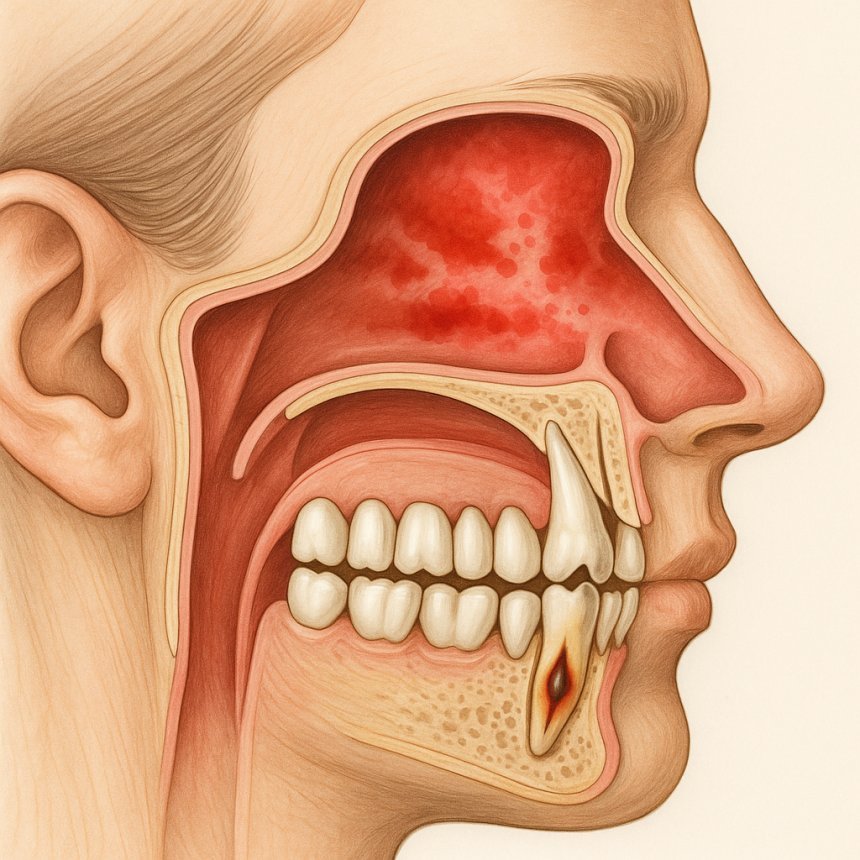The Hidden Culprit Behind Persistent Sinusitis: Your Teeth Might Be to Blame.
Is your chronic sinusitis just not going away? Your teeth might be the reason! Discover the strong connection between maxillary sinuses and dental health through scientific evidence. The hidden cause behind persistent sinusitis could be dental root infections.

The Hidden Culprit Behind Persistent Sinusitis: Could It Be Your Teeth?
Today, we’re shedding light on a surprisingly common yet often overlooked issue: Odontogenic Maxillary Sinusitis — sinus infections that originate from dental problems.
Have you been experiencing a lingering sinus infection or a constant feeling of pressure in your face? What if we told you that your teeth might be the real cause?
A comprehensive review of 38 scientific studies reveals some striking findings:
Up to 50% of maxillary sinusitis cases in adults may be linked to underlying dental issues. In other words, 1 in 2 cases could be dental in origin.
Why Is This Often Missed?
Because the symptoms typically mimic those of classic sinusitis: nasal congestion, discharge, fullness, and sometimes mild facial pain.
There may be no obvious toothache, so the connection is easily overlooked. Additionally, standard 2D dental X-rays (panoramic imaging) often fail to reveal the root cause.
This is where 3D imaging techniques, like Cone Beam Computed Tomography (CBCT), become crucial.
If You Have Chronic, Treatment-Resistant Sinusitis:
-
Inform your ENT specialist or dentist about your symptoms,
-
Request a 3D scan (CT or CBCT) for a more detailed evaluation — this could be key to accurate diagnosis and effective treatment.
If a dental issue is the underlying cause and remains undetected, conventional sinusitis treatments may fail, or the problem may keep recurring.
Scientific Evidence Indicates:
-
If there is an infection at the tip of a tooth root (apical lesion), the risk of sinusitis in the adjacent sinus increases 4-fold.
-
In cases of gum disease (periodontitis), this risk jumps to 5.5 times.
-
When there is severe bone loss around the teeth, the likelihood may be up to 13.8 times higher.
While further long-term studies are needed for more precise insights, existing data already serve as a strong warning signal for both doctors and patients.
If you suffer from one-sided, chronic, and treatment-resistant maxillary sinusitis, always keep this question in mind:
“Could my teeth be the real cause?”
Remember: Accurate diagnosis prevents unnecessary medication use and leads to lasting solutions.
Reference:
Vitali, F. C., Santos, P. S., Massignan, C., Maia, L. C., Cardoso, M., & Teixeira, C. da S. (2023). Global prevalence of maxillary sinusitis of odontogenic origin and associated factors: A systematic review and meta-analysis. Journal of Endodontics, 49(4), 369–381. https://doi.org/10.1016/j.joen.2023.01.010
Author: Dr. Abdullah ÖZCEYLAN
Editor-in-Chief: İsmet Serhat KAHYA
All content of this article belongs to Dr. Abdullah ÖZCEYLAN, Endodontics Specialist. It may not be copied, reproduced, or published on other platforms without permission.
Share
What's Your Reaction?
 Like
0
Like
0
 Dislike
0
Dislike
0
 Love
0
Love
0
 Funny
0
Funny
0
 Angry
0
Angry
0
 Sad
0
Sad
0
 Wow
0
Wow
0












